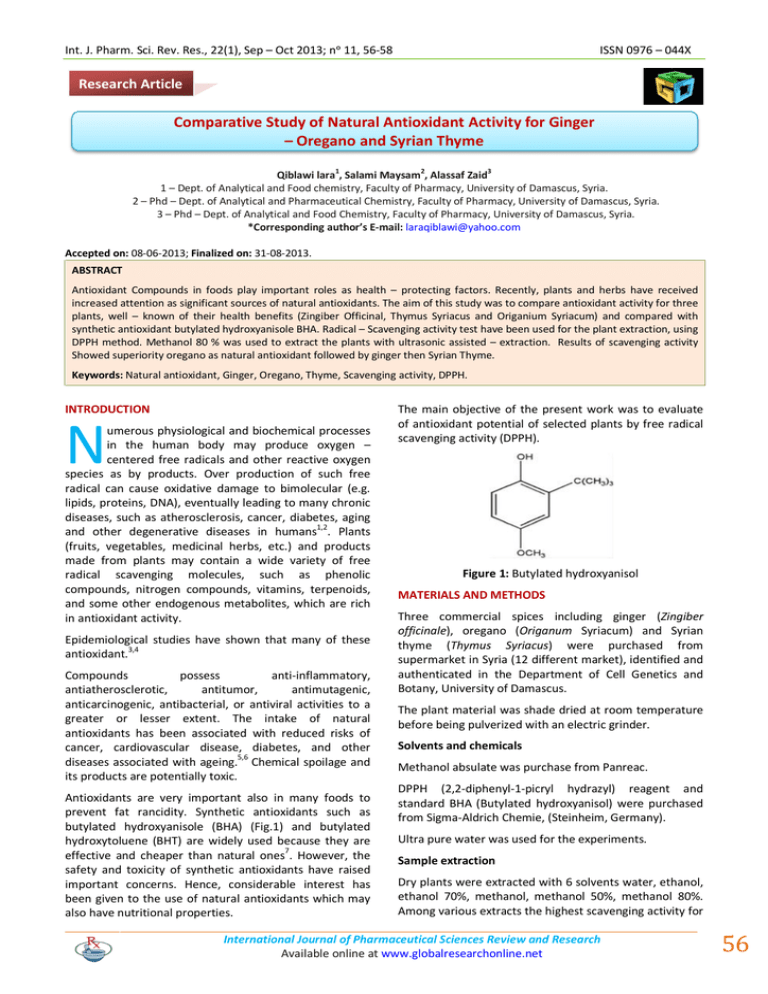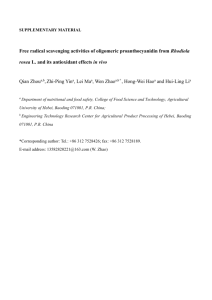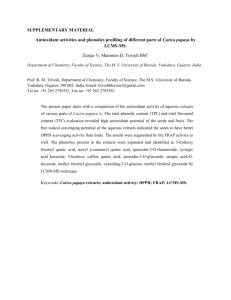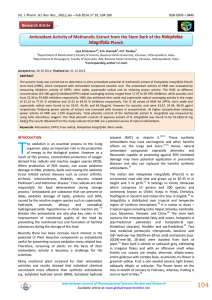Document 13309276
advertisement

Int. J. Pharm. Sci. Rev. Res., 22(1), Sep – Oct 2013; nᵒ 11, 56-58 ISSN 0976 – 044X Research Article Comparative Study of Natural Antioxidant Activity for Ginger – Oregano and Syrian Thyme 1 2 3 Qiblawi lara , Salami Maysam , Alassaf Zaid 1 – Dept. of Analytical and Food chemistry, Faculty of Pharmacy, University of Damascus, Syria. 2 – Phd – Dept. of Analytical and Pharmaceutical Chemistry, Faculty of Pharmacy, University of Damascus, Syria. 3 – Phd – Dept. of Analytical and Food Chemistry, Faculty of Pharmacy, University of Damascus, Syria. *Corresponding author’s E-mail: laraqiblawi@yahoo.com Accepted on: 08-06-2013; Finalized on: 31-08-2013. ABSTRACT Antioxidant Compounds in foods play important roles as health – protecting factors. Recently, plants and herbs have received increased attention as significant sources of natural antioxidants. The aim of this study was to compare antioxidant activity for three plants, well – known of their health benefits (Zingiber Officinal, Thymus Syriacus and Origanium Syriacum) and compared with synthetic antioxidant butylated hydroxyanisole BHA. Radical – Scavenging activity test have been used for the plant extraction, using DPPH method. Methanol 80 % was used to extract the plants with ultrasonic assisted – extraction. Results of scavenging activity Showed superiority oregano as natural antioxidant followed by ginger then Syrian Thyme. Keywords: Natural antioxidant, Ginger, Oregano, Thyme, Scavenging activity, DPPH. INTRODUCTION N umerous physiological and biochemical processes in the human body may produce oxygen – centered free radicals and other reactive oxygen species as by products. Over production of such free radical can cause oxidative damage to bimolecular (e.g. lipids, proteins, DNA), eventually leading to many chronic diseases, such as atherosclerosis, cancer, diabetes, aging and other degenerative diseases in humans1,2. Plants (fruits, vegetables, medicinal herbs, etc.) and products made from plants may contain a wide variety of free radical scavenging molecules, such as phenolic compounds, nitrogen compounds, vitamins, terpenoids, and some other endogenous metabolites, which are rich in antioxidant activity. Epidemiological studies have shown that many of these 3,4 antioxidant. Compounds possess anti-inflammatory, antiatherosclerotic, antitumor, antimutagenic, anticarcinogenic, antibacterial, or antiviral activities to a greater or lesser extent. The intake of natural antioxidants has been associated with reduced risks of cancer, cardiovascular disease, diabetes, and other diseases associated with ageing.5,6 Chemical spoilage and its products are potentially toxic. Antioxidants are very important also in many foods to prevent fat rancidity. Synthetic antioxidants such as butylated hydroxyanisole (BHA) (Fig.1) and butylated hydroxytoluene (BHT) are widely used because they are effective and cheaper than natural ones7. However, the safety and toxicity of synthetic antioxidants have raised important concerns. Hence, considerable interest has been given to the use of natural antioxidants which may also have nutritional properties. The main objective of the present work was to evaluate of antioxidant potential of selected plants by free radical scavenging activity (DPPH). Figure 1: Butylated hydroxyanisol MATERIALS AND METHODS Three commercial spices including ginger (Zingiber officinale), oregano (Origanum Syriacum) and Syrian thyme (Thymus Syriacus) were purchased from supermarket in Syria (12 different market), identified and authenticated in the Department of Cell Genetics and Botany, University of Damascus. The plant material was shade dried at room temperature before being pulverized with an electric grinder. Solvents and chemicals Methanol absulate was purchase from Panreac. DPPH (2,2-diphenyl-1-picryl hydrazyl) reagent and standard BHA (Butylated hydroxyanisol) were purchased from Sigma-Aldrich Chemie, (Steinheim, Germany). Ultra pure water was used for the experiments. Sample extraction Dry plants were extracted with 6 solvents water, ethanol, ethanol 70%, methanol, methanol 50%, methanol 80%. Among various extracts the highest scavenging activity for International Journal of Pharmaceutical Sciences Review and Research Available online at www.globalresearchonline.net 56 Int. J. Pharm. Sci. Rev. Res., 22(1), Sep – Oct 2013; nᵒ 11, 56-58 ISSN 0976 – 044X DPPH, 80% methanol were chosen for further analysis (Fig.2). Table 2: Scavenging activity of ginger samples Scavenging activity Sample 47 48 45 50 52 G1 G2 G3 G4 G5 46 47 49 45 47 G6 G7 G8 G9 G10 45 48 G11 G12 Five gram of dried plant powder were brought to 100 ml 80% methanol. The mixture was left 24 hours for maceration at room temperature (20 °C) and then put in an ultrasonic bath at 40 °C, 2h. The suspension was then vacuum filtered through a ceramic filter with the porosity of 40 µm and centrifuged at 10.000 rpm, 10 min. The methanol was completely removed by vacuum concentrator, at 40 °C to give a viscous mass. The crude extracts were stored at 0-4 °C before analysis. Free Radical Scavenging Activity8 Free radical scavenging activity of samples was measured using the 2,2-difenyl-1-picrylhydrazyl (DPPH) according to the procedures described by Molyneux P, (2004). The sample (plant extract ) 0.1 ml was reacted with 4.9 ml of freshly prepared 0.8 mM DPPH methanolic solution (0.0315 g DPPH in 1 L methanol). Also notice that the scavenging activity average of ginger samples is 47.42%. Table 3: Scavenging activity of S.Thyme samples Scavenging activity 44 47 46 45 48 42 43 45 44 40 46 49 And for synthetic antioxidant attended a series of standard concentrations: 2.5, 5, 7.5, 10, 12.5, 15 µM/ l and so based of the BHA solution with concentration 1 mM / l. They were thoroughly mixed and kept in the dark for completing reaction. Absorbance of the samples was determined using spectrophotometer (HITACHI U – 1800) at 517 nm. the impact of time in DPPH interact with samples has been studying by measuring the absorption every 5 minutes after applying the interaction on the extract as previously stated for 2 hours. Free radical scavenging activity of the samples was expressed according equation: %Inhibition= [ 1 – A / A0 ] × 100 where A0 is the absorbance of DPPH in solution without an antioxidant, and A is the absorbance of DPPH in the presence of an antioxidant. All analyses were performed in triplicates. And the scavenging activity average of the Syrian thyme samples is 45.75%. Table 4: Scavenging activity of BHA Sample O1 O2 O3 68 71 69 72 O4 O5 O6 O7 61 65 72 72 O8 O9 O10 O11 66 O12 We can notice from the table that the scavenging activity average of oregano sample is 69.25%. Scavenging Activity Table 1: Scavenging activity of oregano samples Scavenging activity 72 70 73 Sample T1 T2 T3 T4 T5 T6 T7 T8 T9 T10 T11 T12 Scavenging activity 12.5 25 37 BHA conc µmol/ l 2.5 5 7.5 49 61 73 10 12.5 15 80 70 60 50 40 30 20 10 0 Solvents Figure 2: Best solvent for studied plants International Journal of Pharmaceutical Sciences Review and Research Available online at www.globalresearchonline.net 57 Int. J. Pharm. Sci. Rev. Res., 22(1), Sep – Oct 2013; nᵒ 11, 56-58 ISSN 0976 – 044X RESULTS AND DISCUSSION REFERENCES Natural antioxidants that are present in herbs and spices are responsible for inhibiting or preventing the deleterious consequences of oxidative stress. Spices and herbs contain free radical scavengers like polyphenols, flavonoids and phenolic compounds. In the present paper, we have evaluated the free radical scavenger activity of methanolic extract of ginger (Zingiber officinale), Oregano and Syrian Thyme from 12 different sources and compared with scavenging activity of BHA. 1. Helmut S, “oxidative stress: Oxidants and antioxidants”, Expermental Physiology, 1997, 82, 291 – 295. 2. Valko M, Leibfritz D, Moncol J, Cronin M, Mazur M and Telser J, “Free radicals and antioxidants in normal physiological functions and human disease”, The International Journal of Biochemistry & cell Biology, 2007, 39(1), 44 – 84 . 3. Zheng W and Wang S.Y, “Antioxidant activity and phenolic compound in selected herbs”, Journal of Agricultural and Food Chemistry, 2010, 492, 5165 – 5170. 4. Cotelle N, Bernier J.L, Catteav J.P, Pommery J, Wallet J.C, Gaydou E.M, “Antioxidant properties of hydroxyflavones”, Free Radical Biology and Medicine, 1996, 20, 35 – 43. 5. Sala A, Ricom B, Manez S, “Antiinflammatory and antioxidant properties of Helichrysam italicum”, Journal of Pharmacy and Pharmacology, 2002, 54, 365 - 371. 6. Owen R.W, Giacosa A, Hull W, “Antioxidant / anticancer potential of phenolic compounds isolated from olive oil”, European Journal of cancer, 2000, 36, 1235 – 1247. 7. POKORNY, J. 2007. "Are natural antioxidants better and safer than synthetic antioxidants?” In European Journal of Lipid Science and Technology, 2007, 109, 629–642. 8. Molyneux P, “The use of the stable free radical diphenyl picryl hydrazyl (DPPH) for estimating antioxidant activity”, Songklanakarin J . Sci. Technol, 2004, 26(2), 211 – 219. 9. Mariutti L, Barreto G, Bragagnoln N and Mercadante A,” Free radical scavenging activity of ethanolic extracts from herbs and spices commercialized in Brazil”, Brazilian Archives of Biology and Technology, 2008, 51(6), 1225 – 1232. The study of the impact of time showing those 75 minutes is the time required for color fastness and completely reaction for ginger extract. And those 65 minutes is the time required for color fastness and completely reaction for oregano extract. 60 minutes is the time required for color fastness and completely reaction for extracts of Syrian thyme and 95 minutes is the time required to fully interact with the BHA. The results indicate that Oregano samples showed the highest scavenging activity compared with samples of Syrian thyme and ginger, and it was close to the scavenging activity for BHA (15 µmol concentration which is the higher accepted value we can add it for food). Their high content of phenolic compounds can explain it. Mariutti L, 2008 detected antioxidant activity of some herbs and spices extracts and reported high antioxidant activity for Oregano.9 Ivanisova, 2013 and his colleagues studied the antioxidant effectiveness of a number of plants, and Oregano had a good value for scavenging ability. 10 CONCLUSION In this study, we prepared and evaluated antioxidant activity of selected plant products. Our results showed that tested plant products had noticeably antioxidant effect. Antioxidant compounds from these products with preventive and treatment effect on various diseases can be used for improving the shelf life of food products. 10. Ivanisova E, Tokar M, Mokok K, Bojnanska T, Marecek J and Mendelova A , “Antioxidant activity of selected plant products” J. Microbiology, Biotechnology and food sciences, 2013, 2, 1692 – 1703. Source of Support: Nil, Conflict of Interest: None. International Journal of Pharmaceutical Sciences Review and Research Available online at www.globalresearchonline.net 58





![benzo[d] isoxazole: In vitro Antimicrobial and Antioxidant activity](http://s3.studylib.net/store/data/007006684_1-684f7b1d721ca4abfe74cc96e54598b2-300x300.png)
